
Pool of Radiance is a role-playing video game developed and published by Strategic Simulations, Inc (SSI) in 1988. It was the first adaptation of TSR's Advanced Dungeons & Dragons (AD&D) fantasy role-playing game for home computers, becoming the first episode in a four-part series of D&D computer adventure games. The other games in the "Gold Box" series used the game engine pioneered in Pool of Radiance, as did later D&D titles such as the Neverwinter Nights online game. Pool of Radiance takes place in the Forgotten Realms fantasy setting, with the action centered in and around the port city of Phlan.
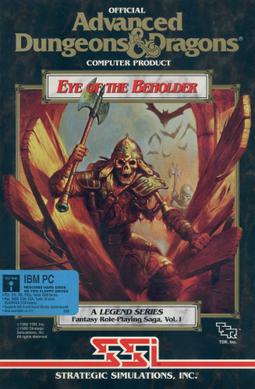
Eye of the Beholder is a role-playing video game for personal computers and video game consoles developed by Westwood Associates. It was published by Strategic Simulations, Inc. in 1991, for the MS-DOS operating system and later ported to the Amiga, the Sega CD and the SNES. The Sega CD version features a soundtrack composed by Yuzo Koshiro and Motohiro Kawashima. A port to the Atari Lynx handheld was developed by NuFX in 1993, but was not released. In 2002, an adaptation of the same name was developed by Pronto Games for the Game Boy Advance.

Curse of the Azure Bonds is a role-playing video game developed and published by Strategic Simulations in 1989. It is the second in a four-part series of Forgotten Realms Advanced Dungeons & Dragons Gold Box games, continuing the events of Pool of Radiance.

Pools of Darkness is a role-playing video game published by Strategic Simulations in 1991. It is the fourth entry in the Pool of Radiance series of Gold Box games, and the story is a continuation of the events of the third game, Secret of the Silver Blades. Like the previous games in the series, it is set in the Forgotten Realms, a campaign setting from Dungeons & Dragons. Players must stop an invasion from an evil god, eventually traveling to other dimensions to confront his lieutenants.
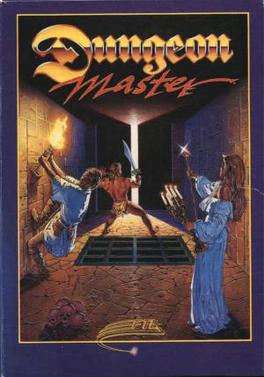
Dungeon Master is a role-playing video game featuring a pseudo-3D first-person perspective. It was developed and published by FTL Games for the Atari ST in 1987, almost identical Amiga and PC (DOS) ports following in 1988 and 1992.

Ultima VI: The False Prophet, released by Origin Systems in 1990, is the sixth part in the role-playing video game series of Ultima. It is the third and final game in the "Age of Enlightenment" trilogy. Ultima VI sees the player return to Britannia, at war with a race of gargoyles from another land, struggling to stop a prophecy from ending their race. The player must help defend Britannia against these gargoyles, and ultimately discover the secrets about both lands and its peoples.

Secret of the Silver Blades is the third in a four-part series of Forgotten Realms Dungeons & Dragons "Gold Box" adventure role-playing video games. The game was released in 1990.

Buck Rogers: Matrix Cubed is a role-playing video game for MS-DOS developed and published by Strategic Simulations 1992. It uses the Gold Box engine. The game takes place in the Buck Rogers XXVC campaign setting. Matrix Cubed is a sequel to Countdown to Doomsday which came out in 1990.

J.R.R. Tolkien's The Lord of the Rings, Vol. I is a role-playing video game published by Interplay Productions. It is an adaptation of The Fellowship of the Ring by J. R. R. Tolkien, being the first volume in The Lord of the Rings. The game was released in 1990 for DOS, in 1991 for the Amiga and PC-98, and in 1992 for the FM Towns. It was followed by J.R.R. Tolkien's The Lord of the Rings, Vol. II: The Two Towers. It was originally designed for the Commodore 64, but the production team switched to the newer platforms. The game was designed by Troy A. Miles, Scott Bennie, Jennell Jaquays, and Bruce Schlickbernd. For the later versions, the cutscenes are taken from the 1978 Lord of the Rings film directed by Ralph Bakshi.
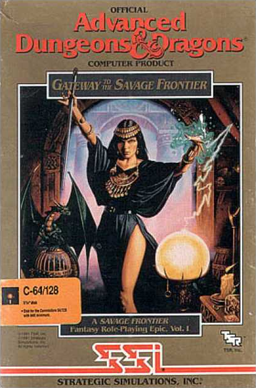
Gateway to the Savage Frontier (1991) is a Gold BoxDungeons & Dragons computer game developed by Beyond Software and published by SSI for the Commodore 64, PC and Amiga personal computers.
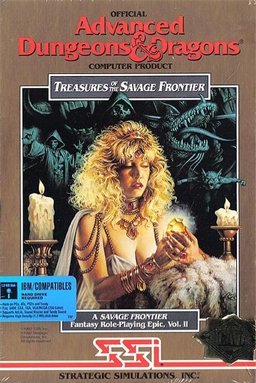
Treasures of the Savage Frontier (1992) is a Gold Box Dungeons & Dragons role-playing video game. It was developed by Beyond Software and published by SSI for the Amiga and DOS.

Champions of Krynn is role-playing video game, the first in a three-part series of Dragonlance Advanced Dungeons & DragonsGold Box games. It was published in 1990 by Strategic Simulations. The highest graphics setting supported in the MS-DOS version is EGA graphics. It also supports the Adlib sound card and either a mouse or joystick.

Death Knights of Krynn is the second in a three-part series of DragonlanceAdvanced Dungeons & Dragons "Gold Box" role-playing video games, published by Strategic Simulations. The game was released in 1991.

Eye of the Beholder III: Assault on Myth Drannor is a 1993 role-playing video game and the sequel to Eye of the Beholder and Eye of the Beholder II: The Legend of Darkmoon.
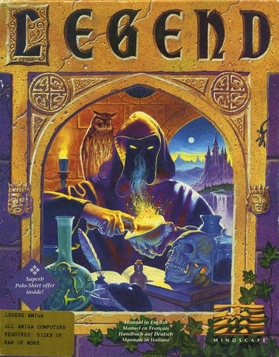
Legend, also known as The Four Crystals of Trazere in the United States, is an isometric fantasy role-playing game released in 1992 for the Amiga, Atari ST, and DOS. It was developed by Pete James and Anthony Taglione for the then UK-based Mindscape, and published by The Software Toolworks. In the game, the player controls four adventurers on a quest to save the land of Trazere from an ancient, re-awakening evil. In 1993, Mindscape released a sequel, Worlds of Legend: Son of the Empire. The copyrights for both "Legend" and "Worlds of Legend" are currently owned by Ubisoft, who bought them from Mattel Interactive with the rest of the Mindscape library in 2001.

Shadow Sorcerer is a role-playing video game published in 1991 by Strategic Simulations. The game is the sequel to Heroes of the Lance and Dragons of Flame. It is based on the third and fourth Dragonlance campaign modules, Dragons of Hope and Dragons of Desolation.
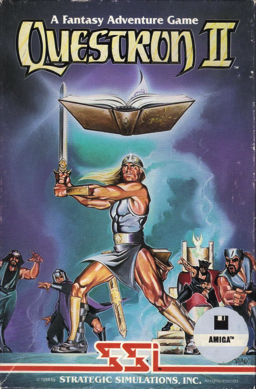
Questron II a 1988 role-playing video game published by Strategic Simulations for the Apple II, Apple IIGS, Atari ST, Commodore 64, IBM PC compatibles, and Amiga. It is the sequel to 1984's Questron. The story and original design is credited to Quest Software, while the programming and artwork is credited to Westwood Associates.

Elvira: Mistress of the Dark is a horror adventure/role-playing video game developed by Horror Soft and released by Accolade in 1990 for the Amiga, Atari ST, Commodore 64 and MS-DOS computers. It was Horror Soft's second published game after 1989's Personal Nightmare and stars the actress Cassandra Peterson as her character Elvira.

Elvira II: The Jaws of Cerberus is the second game in the Elvira series of horror adventure/role-playing video games. It was developed by Horror Soft and published by Accolade in 1992. The game is a sequel to 1990's Elvira: Mistress of the Dark. It was followed by Waxworks, which can be considered its spiritual sequel.
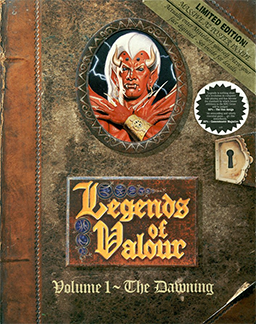
Legends of Valour is a role-playing video game developed by Synthetic Dimensions and released by U.S. Gold and Strategic Simulations in 1992 for the Amiga, Atari ST and MS-DOS, with the additional FM Towns and PC-98 versions in 1993-1994 in Japan only. As the game was planned to be a first part of the series, its full title is Legends of Valour: Volume I – The Dawning. The proposed unreleased sequel to Legends of Valour was to take place in the world outside Mitteldorf, the enclosed city where the entirety of Legends of Valour takes place.





















